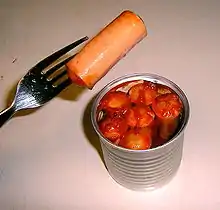Vienna sausage
A Vienna sausage (German: Wiener Würstchen, Wiener; Viennese/Austrian German: Frankfurter Würstel or Würstl; Swiss German: Wienerli; Swabian: Wienerle or Saitenwurst) is a thin parboiled sausage traditionally made of pork and beef in a casing of sheep's intestine, then given a low temperature smoking.[1][2] The word Wiener is German for Viennese.[3] In Austria, the term "Wiener" is uncommon for this food item, which instead is usually called Frankfurter Würstl.[4]


The ingredients, preparation, size, and taste can vary widely by both manufacturer and region of sale.
Europe
In some European countries, cooked and often smoked wiener sausages bought fresh from supermarkets, delicatessens and butcher shops may be called by a name (such as in German or French) which translates in English as "Vienna sausage". Traditionally, they are made from spiced ham, but in Eastern and Southern Europe chicken and/or turkey filled frankfurters are more common. Wieners sold as Vienna sausage in Europe have a taste and texture very much like North American "hot dogs" or "frankfurters", but are usually longer and somewhat thinner, with a very light, edible casing. European Vienna sausage served hot in a long bun (kipfel) with condiments is often called a "hot dog", referring not to the wiener itself, but to the long sandwich as a whole.[5][6][7][8][9] In Norway wiener sausages are typically served in a lefse lompe.
North America
After having been brought to North America by European immigrants, "Vienna sausage" came to mean only smaller and much shorter smoked and canned wieners, rather than link sausage, beginning about 1903.[10][11] However, they have no federal standard of identity.[12] North American vienna sausages are made similarly to pork wieners, finely ground to a paste consistency and mixed with salt and various spices, such as cloves, coriander, nutmeg, garlic powder, onion powder and finely ground, dry red pepper.[13] The sausages are stuffed into a long casing, sometimes smoked, always thoroughly cooked and beginning in the 1950s, the casings were removed.[10] The sausages are then cut into short segments for canning and further cooking. They are available plain (in a gelatin, similar to aspic) or with a variety of flavorings, such as smoke, mustard, chili or barbecue sauces. Consumption of Vienna sausages peaked in the 1940s to 1970s, but has declined since then.[10]
See also
References
- "Discounter: Der Kampf um das billigste Wiener Würstchen". Die Welt (in German). 2015-10-15. Retrieved 2016-09-17.
- "Wiener Würstchen". Bund für Lebensmittelrecht und Lebensmittelkunde (in German). 2016-08-24. Retrieved 2016-09-17.
- "Wiener {1} translation English - German dictionary - Reverso". reverso.net.
- "Warenkunde - Frankfurter oder Wiener - gibt es einen Unterschied?". Bundesverband der Deutschen Fleischwarenindustrie (in German). 2011-06-06. Retrieved 2016-09-17.
- "Dictionar Culinar - Retete Culinare". Reteteculinare.ro. 2015-04-30. Retrieved 2015-10-08.
- "· mynetfair". Mynetfair.com. Retrieved 2015-10-08.
- BàS / n° 200602 (p.16-17). "Bon à savoir > Services > Recherche > Grasse saucisse de Vienne". Bonasavoir.ch. Retrieved 2015-10-08.
- "Le premier supermarché en ligne de Suisse". LeShop.ch. Retrieved 2015-10-08.
- "Le premier supermarché en ligne de Suisse". LeShop.ch. Retrieved 2015-10-08.
- Andrew F. Smith (2007). The Oxford Companion to American Food and Drink. Oxford University Press. p. 611. ISBN 9780199885763. Retrieved 8 January 2018.
- "Vienna Sausage | Definition of Vienna sausage by Merriam-Webster". Merriam-webster.com. Retrieved 2015-10-08.
- A.M. Pearson & T.A. Gillett (1996). Processed Meats. Springer Science & Business Media. p. 397. ISBN 9780834213043. Retrieved 8 January 2018.
- C. Devine & M. Dikeman (2014). Encyclopedia of Meat Sciences. Elsevier. p. 245. ISBN 9780123847348. Retrieved 8 January 2018.
External links
 Media related to Vienna sausages at Wikimedia Commons
Media related to Vienna sausages at Wikimedia Commons
